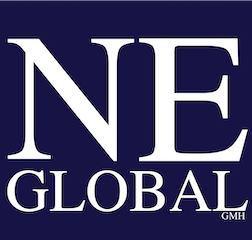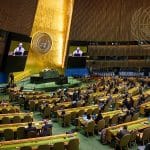U.S. President Donald Trump completed his five-day “private visit” to Scotland on July 25-29, which beyond his golf course visits included a number of important official meetings, chief among them the July 27 meeting with European Commission President Ursula von der Leyen during which the final negotiations were held allowing for the signature of the U.S.-EU framework trade agreement which is by far the key development, but not the only newsworthy item, from the latest Trump overseas jaunt.
With U.S.-EU negotiations fast approaching Trump’s looming August 1 deadline, the pressure was clearly on both sides to reach agreement which Trump had called “a 50-50 chance” just a day before meeting Von der Leyen. Of course, agreement critics on both sides of the Atlantic multiplied like weeds, but it is clear to all that an agreement reached under a Washington-imposed deadline would create the impression of EU submission to Trump’s pressure tactics and much anger focused on the perceived lack of hardball negotiating tactics employed by Brussels, even though the European Commission had made it clear on multiple occasions that it was fully prepared to retaliate if needed. In the end it agreed to another one of Trump’s “announce first, details later” style deals.
Key agreement elements
A flat 15 percent import tariff will apply to the vast majority of EU exports to the U.S., including automobiles (previously 27.5 percent from last April). Mirroring somewhat the recent U.S. deal with Japan, these new tariffs replace the threatened 30 or 50 percent rates heard from the White House at different junctures. This 15 percent tariff rate does not stack on existing tariffs – it replaces them.
Major exceptions are steel and aluminum tariffs, which remain at the Trump-imposed 50 percent, but both sides agreed to negotiate quota systems that may allow some imports at reduced or zero rates in the future. No immediate reductions were enacted.
Another large cut-out, with details yet to be released, is the exemptions for strategic goods. Zero-for-zero tariff exemptions will be put in place for strategic goods which includes aircraft and aircraft parts, semiconductor manufacturing equipment, certain chemicals, generic drugs, select agricultural products, and critical raw materials. That exemption list may expand over time.
Important sectors were left to be negotiated later in order to reach agreement. Pharmaceuticals and semiconductors remain under separate U.S. “Section 232” investigations with results expected in a matter of weeks. Any exceptions for these sectors will be determined independently. Another missing but highly important sector awaits clarification as no definitive terms were agreed for spirits, wine, and other farm-export goods — but negotiations are ongoing, and this will be clarified soon. “Announce first, details later” is the way Trump’s trade negotiators overcome roadblocks, it seems.
Throughout the negotiations that preceded the deal, American officials consistently denounced the EU’s extensive regulatory framework, calling for the abolition of its digital rules, extensive food safety standards and value-added tax (VAT) as top irritants. European Commission officials maintain the bloc made no commitments to modify any of its regulatory framework, much of which was specifically developed by politically-directed Commission officials to restrict the growth of U.S. tech and agricultural giants in the EU market.
EU pledges – most likely simple targets
The EU pledged to buy $250 billion of U.S. liquefied natural gas (LNG) a year for three years, totaling $750 billion in total, as it is intended to replace Russian gas, but questions remain about the actual U.S. export capacity, which is currently substantially lower. The new targets may, however, encourage domestic investment in this sector.
The EU will also buy U.S. nuclear fuel instead of supplies from other sources. Under the deal, the EU also pledged to buy U.S. military equipment and European companies are to invest $600 billion in the U.S. over the course of Trump’s second term, which is in fact not a huge increase from market driven transactions seen in previous years.
The bottom line
The agreement is a stabilizing breakthrough, preventing the pending trade war and providing predictability for businesses on both sides of the Atlantic, a key issue for leaders on both sides of the ocean. However, it is impossible to deny the fact that the 15 percent tariff level approaches, but remains somewhat below, the punishing Smoot-Hawley tariffs in place in the U.S. in the 1930s, and is far higher than pre‑Trump levels (around 1-2 percent) and this is expected to raise U.S. consumer prices, reduce profits for European exporters, and hurt sectors like autos and pharmaceuticals.
Von der Leyen, announcing the deal alongside Trump on July 27, said, “We have a deal. We have a trade deal between the two largest economies in the world, and it’s a big deal, it’s a huge deal. It will bring stability. It will bring predictability.”
Trump noted, “I think we both wanted to make a deal,” and he predicted it would “bring us closer together.” Mr. Trump also said more than once to reporters on July 27 that it was the “biggest of all the deals.”
Several European industrial groups immediately labeled the agreement an “inadequate compromise” for export-dependent economies. Deal critics seem to be multiplying, and as more agreement details emerge, we will no doubt witness more sector-specific complaints as various industries calculate the losses to their bottom lines.
The EU Commission President hailed the deal as “the best possible under difficult circumstances,” emphasizing the need for stability and predictability. Initial reaction to the deal has been some downward pressure on the euro/dollar exchange rate.
Quite a number of EU leaders fall into this “pro-predictability” camp, including leaders from Germany, Ireland, Finland, and Denmark, with most noting the advantages of predictability for industry and the difficulties of the negotiating parameters involving Trump. Leaders from Italy and Spain were more neutral in their assessments, needing full details before making a judgement. However, officials from France and Hungary were open in their condemnation of the deal and the EU’s negotiating stance.
For example, a combative France has been leading the charge for more aggressive EU actions, as its officials often do within EU meetings, and some are now reportedly asking for the activation of the EU’s “anti-coercion instrument” to retaliate against the U.S., a step that currently lacks broader EU consensus. French Prime Minister Francois Bayrou declared, “It is a somber day when an alliance of free peoples, brought together to affirm their common values and to defend their common interests, resigns itself to submission.”
Hungary’s Prime Minister Viktor Orbán also harshly criticized the deal, declaring, “This is not an agreement. Donald Trump ate von der Leyen for breakfast” and calling Ursula von der Leyen a “featherweight” negotiator against Trump’s “heavyweight” tactics.
EU approval process to be streamlined
As the deal is not a formal trade agreement, it is not expected to require full EU treaty approval procedures. However, the European Council (i.e., national leaders or ministers) must review and endorse the deal. For non-legally binding or time-limited agreements, qualified majority approval from member states may suffice. If the deal is later formalized into a binding legal agreement, it will require unanimity or formal ratification.
In addition, the European Parliament must be consulted and must give consent if the agreement is to be legally binding, especially for parts affecting EU legislation (e.g., tariffs, quotas).








